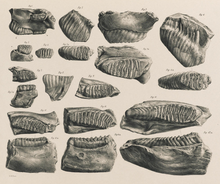| Elephas hysudricus Temporal range: Early Pleistocene–Middle Pleistocene PreꞒ Ꞓ O S D C P T J K Pg N ↓ | |
|---|---|

| |
| Teeth of Elephas hysudricus from the species description by Hugh Falconer and Proby Thomas Cautley | |
| Scientific classification | |
| Domain: | Eukaryota |
| Kingdom: | Animalia |
| Phylum: | Chordata |
| Class: | Mammalia |
| Order: | Proboscidea |
| Family: | Elephantidae |
| Genus: | Elephas |
| Species: | †E. hysudricus |
| Binomial name | |
| †Elephas hysudricus (Falconer and Cautley, 1845) | |
| Synonyms | |
|
Hypselephas hysudricus | |
Elephas hysudricus is an extinct elephant species known from the Pleistocene of Asia. It is thought to be ancestral to the living Asian elephant, from which it is distinguished by the molar teeth having a lower crown height and a lower lamellae number. Remains of the species are primarily known from the Indian subcontinent, with the most important remains coming from the Siwalik Hills. The oldest remains of the species in the Siwaliks are placed at around 2.6 million year ago at the beginning of the Early Pleistocene, with the youngest dates in the Siwaliks during the Middle Pleistocene around 0.6 million years ago, though it likely persisted on the subcontinent later than this based on remains found elsewhere.
Remains likely attributable to the species are also known from the Levant in Israel and Jordan, dating to the late Middle Pleistocene, likely sometime between 500-100,000 years ago. Isotopic analysis of specimens from the Indian subcontinent suggests that early members of the species were likely primarily grazers, but shifted towards mixed feeding (both browsing and grazing) after the arrival of the substantially larger elephant species Palaeoloxodon namadicus to the region. It is suggested to be closely related and possibly ancestral to the extinct Elephas hysudrindicus from the Pleistocene of Java in Indonesia.
References
- Nanda, A. C. (2002). "Upper Siwalik mammalian faunas of India and associated events". Journal of Asian Earth Sciences. 21 (1): 47–58. Bibcode:2002JAESc..21...47N. doi:10.1016/S1367-9120(02)00013-5.
- ^ Lister, Adrian M.; Dirks, Wendy; Assaf, Amnon; Chazan, Michael; Goldberg, Paul; Applbaum, Yaakov H.; Greenbaum, Nathalie; Horwitz, Liora Kolska (September 2013). "New fossil remains of Elephas from the southern Levant: Implications for the evolutionary history of the Asian elephant". Palaeogeography, Palaeoclimatology, Palaeoecology. 386: 119–130. Bibcode:2013PPP...386..119L. doi:10.1016/j.palaeo.2013.05.013.
- Pokines, James T.; Lister, Adrian M.; Ames, Christopher J. H.; Nowell, April; Cordova, Carlos E. (March 2019). "Faunal remains from recent excavations at Shishan Marsh 1 (SM1), a Late Lower Paleolithic open-air site in the Azraq Basin, Jordan". Quaternary Research. 91 (2): 768–791. Bibcode:2019QuRes..91..768P. doi:10.1017/qua.2018.113. ISSN 0033-5894. S2CID 134216492.
- Patnaik, Rajeev; Singh, Ningthoujam Premjit; Paul, Debajyoti; Sukumar, Raman (November 2019). "Dietary and habitat shifts in relation to climate of Neogene-Quaternary proboscideans and associated mammals of the Indian subcontinent". Quaternary Science Reviews. 224: 105968. Bibcode:2019QSRv..22405968P. doi:10.1016/j.quascirev.2019.105968. S2CID 210307849.
- Vidya, T.N.C; Sukumar, Raman; Melnick, Don J (2009-03-07). "Range-wide mtDNA phylogeography yields insights into the origins of Asian elephants". Proceedings of the Royal Society B: Biological Sciences. 276 (1658): 893–902. doi:10.1098/rspb.2008.1494. ISSN 0962-8452. PMC 2664373. PMID 19019786.
| Taxon identifiers | |
|---|---|
| Elephas hysudricus | |
This article about a prehistoric proboscidean is a stub. You can help Misplaced Pages by expanding it. |